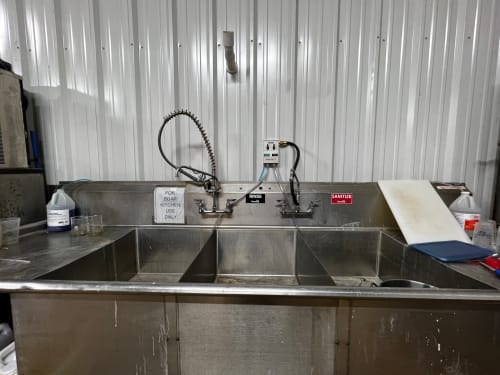
Preventing foodborne illnesses from spreading throughout food contact surfaces is essential for health code requirements and maintaining a healthy facility. It's as easy as 1, 2, 3, as long as you teach the proper steps to your kitchen staff in the correct order for the entire cleaning process.
What is a three compartment sink?
A three compartment sink is an alternative solution to a commercial dishwasher. In a three compartment sink, there are three compartments which serve different cleaning purposes. The three sink method consists of washing, rinsing and sanitizing. The entire cleaning procedure exists to efficiently clean and sanitize dishware inside food facilities.
Does my facility require a 3 compartment sink?
The FDA requires all food preparation, food dispensing and food services to acquire a three compartment sink within their facility. The purpose of three compartment sinks is to reduce the level of cross contamination between raw meat and food contact surfaces from spreading to consumers. Without proper cleaning procedures, the risk of foodborne illness within a facility is much higher.
However, commercial dishwashers are acceptable for FDA health code requirements as long as the dishware and appliances are dishwasher safe, properly washed and left to air dry.
Facilities that must have a three compartment sink include:
-
Commercial kitchens
-
Food trucks
-
Restaurants
-
Bars containing food
Five steps to the three compartment sink method
Although the cleaning procedure is a three sink method, there are five steps order to properly clean dishware and utensils in this type of sink.
Follow the steps below:
1. Remove leftover food on the dishware
Scrape off any leftover food components into a disposal bin. Make sure each food item is removed from the dishware, then collect all dishes and utensils before the wash cycle starts.
2. Scrub with soap
Set the water temperature between 95ºF and 120ºF degrees in the wash sink. Begin by thoroughly scrubbing each dish individually with soap until all dried food, stains and grease are discarded. Transfer the clean dishes into the second sink for rinsing.
3. Rinse the dishes
Fill the second sink with hot water to a minimum of 110ºF. Place the dish or kitchen tools into the water to submerge. Allow time for all the soap residue to rinse off the dishes.
4. Soak in chemical sanitizers
Following the rinse step, transfer the dish or utensil into the third sink for sanitizing. The proper temperatures for the sanitizing sink must be at least 171ºF with the appropriate chemical sanitizer such as Alpet No-Rinse Quat Sanitizer or a chlorine solution. The dishware and utensils must have immersion times between 30 and 60 seconds to properly sanitize dishes.
Typically, each chemical sanitizer will indicate proper use on the product label.
5. Air dry dishware
After sanitizing dishes, place all hygienic dishes onto the designated drying surface or rack. Dishes must be left to air dry. Use of towel or other drying methods will increase the chance of cross contamination.
Washing Sink - First Sink Method
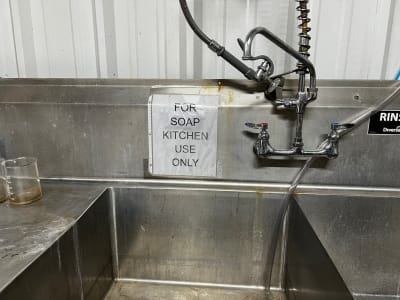
The first sink method is designated for cleaning and washing dishes. The soapy water must contain a soap or degreaser with a sufficient sponge or brush for scrubbing and removing all leftover food. Fill the sink with warm water between 95ºF and 120ºF degrees for an effective clean.
In order to remove all buildup on the dishes and utensils, it is important to wash each container until all oils and stains are eliminated. With a high water temperature, it's recommended that employees wear gloves to protect themselves from hot water.
Rinsing Sink - Second Sink Method
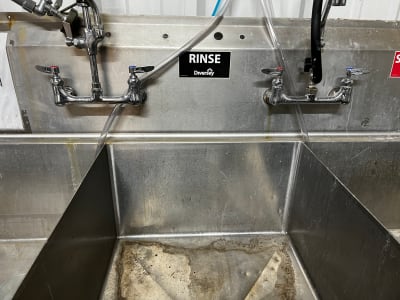 After the wash cyle, transfer dishware into the second sink to rinse and clear all soap residue from the container or equipment. The second compartment is strictly used for rinsing dishes. Fill the sink with warm, clean water and rinse each dish. The water tempature is the same as the wash sink, the only difference is the rinse sink does not contain soap or chemicals.
After the wash cyle, transfer dishware into the second sink to rinse and clear all soap residue from the container or equipment. The second compartment is strictly used for rinsing dishes. Fill the sink with warm, clean water and rinse each dish. The water tempature is the same as the wash sink, the only difference is the rinse sink does not contain soap or chemicals.Do not use any chlorine bleach, chemical sanitizing solution or regular bleach in the second sink.
Sanitizing Sink - Third Sink Method
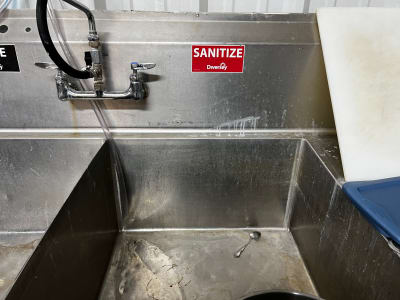 The third compartment method is the most important step for the five step process. Fill the third sink with hot water with a minumum temperature of 171ºF. In order to kill pathogens on the surface, the water temperature needs to be monitored using a gauge. Bacteria and germs cannot survive in hot water of this degree.
The third compartment method is the most important step for the five step process. Fill the third sink with hot water with a minumum temperature of 171ºF. In order to kill pathogens on the surface, the water temperature needs to be monitored using a gauge. Bacteria and germs cannot survive in hot water of this degree.Apply a sanitizing solution such as bleach or sanitizer to dilute the water for sanitizing. For bleach or chlorine chemical sanitizing solution within the third sink, use test strips to measure the chemical concentration.
Sanitizing dishes cannot be rushed. Each dish must remain submerged in the sanitizer sink for at least 30 seconds and up to 1 minute. Once the time is finished, the dishes are fully sanitized and ready to air dry.
With continuous sanitizing throughout a given day, exchange and refill the sink with a new chemical or regular bleach after two to four hours. Due to the sensitive chemicals and high water temperature, it is highly recommended to wear gloves when conducting the third sink method.
Chemical Sanitizing Solution
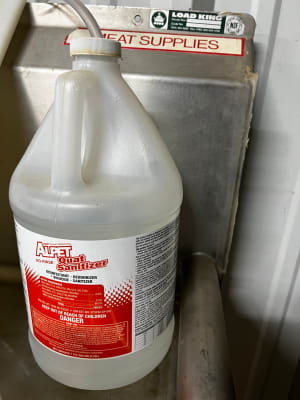
Alpet No-Rinse is an ideal, three compartment sink sanitizer. The sanitizer will efficiently sanitize dishes without leaving behind a strong odor. Alpet No-Rinse is a versatile cleaner which can be used in water or on hard surfaces. Therefore, the sanitizer is the perfect two in one solution for the front and back of house; a general cleaner for food contact surfaces and bacteria eliminator when sanitizing dishware. Follow instructions for the third sink process and apply this solution to the water.
Alpet No-Rinse Quat Sanitizer:
-
Disinfects in 10 minutes
-
Dilutable sanitizer, deodorizer, virucide and disinfectant
-
Effective drain sanitizer
Check out other sanitizer solutions for a three compartment sink listed on Southland Sanitize.
Washing Tableware with Liquid Detergent
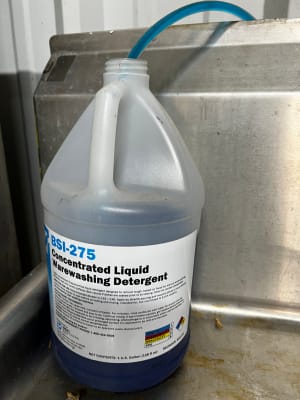 BSI-275 Concentrated Liquid Warewashing Detergent is a liquid detergent for the first compartment sink. This highly concentrated fragrance-free cleaner removes tough foods and stains on the dishware surface. Apply directly into the sink or dispenser machine to dilute the soap into the water. Allow the detergent to soak in the sink before scrubbing begins.
BSI-275 Concentrated Liquid Warewashing Detergent is a liquid detergent for the first compartment sink. This highly concentrated fragrance-free cleaner removes tough foods and stains on the dishware surface. Apply directly into the sink or dispenser machine to dilute the soap into the water. Allow the detergent to soak in the sink before scrubbing begins.BSI Liquid Warewashing Detergent:
-
Does not contain phosphates
-
Safe for flatwares, dishes and utensils
Dual Soap and Sanitizer Dispenser for Sinks
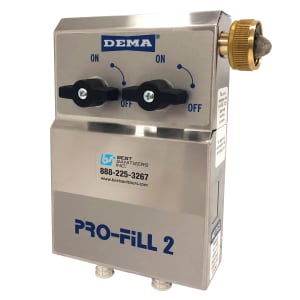
BSI DEMA PRO-FILL 2 Sink Dispenser is a double action appliance that fills multiple sinks with solution by the switch of a valve. The sink dispenser automatically dispenses sanitizer or chemicals into the water while diluting a specific measured amount.
Using this dispenser is a simple process. Attach a water hose to both sides of the machine. Insert each hose inside the desired solution and switch the valve on when ready to use. BSI DEMA PRO FILL is an efficient and systematic device to use for dual dispensing, quick cleaning and preventing liquid mess.
BSI DEMA Sink Dispenser:
-
Dual dispenser and soap distributor
-
Faucet adaptor is sold separately
How to Clean a Stainless Steel Sink
By now, you have read about the basic information on how a three compartment sink works and the proper steps to perform its necessary cleaning procedures. Although a compartment sink's main duty is to clean and sanitize dishware, the sink itself is still susceptible to containing bacteria among the surface. Microorganisms and other pathogens will develop inside the sink if it's never cleaned.
After daily washing operations are complete, scrub down each sink with sanitizer. Grab a rag and surface sanitizer and begin by spraying down the outer, inner and corner areas of the sink surfaces. Wipe away all residue on the surface and discard the towel or rag. Regularly clean a three compartment sink before and after each use.
Employees may want to wear gloves when cleaning a 3 compartment sink due to sensitive chemicals.
How to Prevent Cross Contamination from Spreading into a Three Compartment Sink
Cross contamination can cause serious issues within a food service facility. The chances of transferring pathogens inside a three compartment sink is higher than one may think. Three compartment sinks are designed for cleaning, rinsing and sanitizing dishes. With an uneducated or unfamiliar staff, many contamination circumstances may occur. However, a few safety measures can simply fix the potential risk of foodborne illness from spreading throughout a facility.
Follow the guidelines listed below:
-
Do not use the sink as a handwashing or preparation station.
The 3 compartment sink should only be used for cleaning dishes, utensils and appliances. Preparing raw foods, washing hands or storing any item is not acceptable.
-
Do not dump mop water in the three compartment sink.
The compartment sink is not a sanitation station for dirty floor water. Please discard mop water in designated drain.
-
Fill sinks with appropriate water temperature and chlorine solution.
In order to fulfill the cleaning procedures required for three compartment sinks, always test key ingredients used for the third sink and temperatures for all 3 sinks.
-
Sinks are not for storage.
Bacteria build up can easily occur when using any sink for purposes other than cleaning, especially storage. Make the easy switch and transfer all items to another more appropriate location.
-
Eliminate all food debris before the cleaning process begins.
Follow the five steps for cleaning dishes properly and scrape away all leftover food from dishware before starting the washing cycle.
Questions?
If you have any questions on how to use our products at a three compartment sink, please reach out to brad@southlandsanitize.com.

